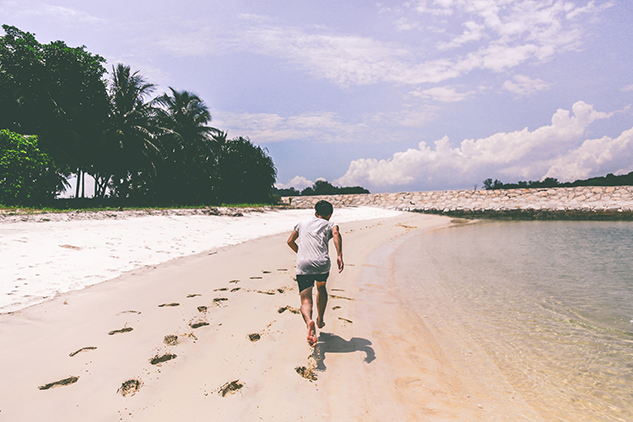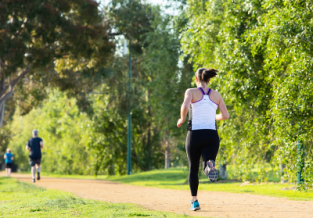9 Reasons Why Running Makes You Healthier & Happier
Published on
22 Feb 2016


Written by
Roy Dookia
Consultant Physiotherapist
Call us on: (03) 9975 4133
Studies show that runners are more likely to be healthier and happier than their non-running counterparts. If you're a regular jogger, then you probably already knew that.
That’s because you will have experienced the benefits of running, either while in the midst of pounding the pavement on your favourite track, or long afterwards. Because the rewards of running extend far beyond the experience of the actual run itself. Running helps you out in the short term and even well into old age.
Done two or three times a week, a simple run is a fantastic way to boost your overall fitness. But jogging can also positively impact on your finances, your food intake, your general mood, and how well you sleep at night. Let’s take a look at why running is one of the fastest ways to health and happiness.
1. Positive emotions run high.
Studies have proven that your brain releases endorphins and other beneficial hormones when you run. Endorphins are neuropeptides that are produced by the central nervous system and pituitary gland. Once they’re released, they attach to receptors in parts of the brain that are commonly associated with positive emotions (specifically, the limbic system and prefrontal areas).
From an evolutionary perspective, these ‘feel good’ brain chemicals are supposed to assist you through the physical discomfort of strenuous exercise. While they occur in cycling and swimming, they’re most commonly observed during running. The ‘runner’s high’ is real!
2. That ‘high’? Low cost.
Unlike the gym, there’s no membership fee for the running track. You can save on those subscriptions. And it’s never closed either: you can run in the morning, mid-afternoon or at midnight. So that joyous sense of elation and freedom that you get from the scientifically-proven release of endorphins? It’s free!
3. Ready, set, go-go-gadget.
Although, if you do want to spend some of that money you’ve freed up, you’ll find there are some incredible devices that can help you hone your skills and track your progress. Monitoring your incremental development is a great way to stay motivated and stick to an exercise program. You can gauge your speed, heart rate, and all kinds of other interesting physiological data.
We’re currently testing two devices right now, in our series of test run articles: head over to see how the Apple Watch stacks up against the Garmin Forerunner 220 Sports. Even if you’re not interested in watches or performance tracking, there’s always the retail-induced rush of joy that comes with a new pair of runners or some fresh new exercise gear.
4. Variety is the spice of life.
Many workouts can be monotonous. By definition, you do weights in sets of “repetitions”. While we’re certainly not encouraging you to drop the dumbbells, a nicely planned jog can be a great way to explore parts of the city that you rarely visit, or a good excuse to check out a new café in a nearby area. Every single run is different, and a new run can offer a widely varying physical workout: up hills, sprints, longer distance, shorter distance, whatever you feel like.
A new route will keep you stimulated and motivated. Plus, we’ve got a series of upcoming ‘run reviews’ that will take you around our favourite tracks in Melbourne, so why not check back for an easy way to mix up your workout?
5. Increase your intake.
Remember that quick café stop we just suggested? Well, when you’re running, carbs are well and truly on the menu. Bread, pastas, biscuits, as well as the traditional whole grain and healthy carbohydrates, can all be enjoyed guilt-free by the regular runner. Simple, fast acting carbs are ideal running fuel, and upping your intake – carefully and strategically – can help you run better for longer, and even help with faster recovery.
6. Get fitter, faster.
High intensity running, at around 65-85% of your maximum heart rate (MHR), can burn as much as 600 calories per hour. Plus, running stimulates high metabolic rates for long periods after exercise. So your workout doesn’t necessarily stop, even if you have!
7. Jog for healthier joints.
Lots of people suggest that running can be damaging for knees, hips and ankles. The truth is actually the opposite: if you don’t run, then you might be running the risk of osteoarthritis (OA). Take a look at this study, which suggests that running can significantly reduce the potential instance of OA due to running’s association with a healthier overall lifestyle and lower BMI.
8. Fit to your schedule.
Time neutral exercise is a thing of beauty. One of the toughest things about going to the gym is exactly that – getting there. Time spent in transit tends to mount up: heading home after work to pick up a bag with all of your gear, physically going to the gym, and coming back. The whole process can be just as tiring (and not to mention time consuming) as the actual workout itself.
If you can run to and from work, (or even to and from the gym!) you’re getting valuable exercise while cutting out any potential expenses involved with your commute. Plus, you’ll be completely energized for the day ahead.
9. Running = relaxing.
Regular running is proven to increase confidence, lower the symptoms associated with stress, depression and anxiety, and improve sleeping patters. Next time you’re feeling overwhelmed, lace up your trainers and run those stress levels down.
***
A regular jogging program is proven to increase our quality of life in more ways than one.
In addition to keeping fit, running can offer convenience and variety to your exercise. So if you’re looking to take up running, or you’re an experienced runner looking to up the ante, get in touch with our team. We can help you in any stage of your jogging journey!
About the Author
Roy Dookia — Consultant Physiotherapist
Roy is a New Zealand trained Physiotherapist, completing his degree at the University of Otago in 2007. Roy is very holistic in his treatment approach and considers contributions from all parts of the body when resolving injuries.


